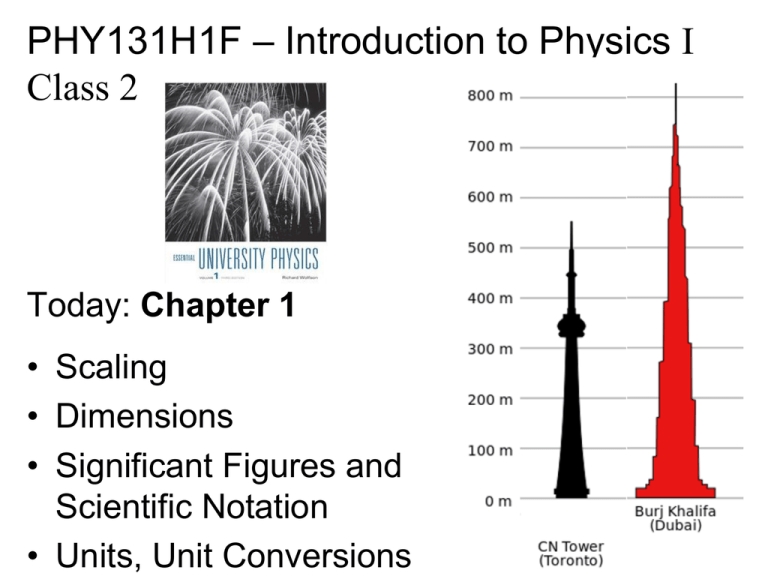Slides posted after class
advertisement

PHY131H1F – Introduction to Physics I Class 2 Today: Chapter 1 • Scaling • Dimensions • Significant Figures and Scientific Notation • Units, Unit Conversions Garden-Variety Clicker Instructions Status Light Power Light When I start asking clicker questions: • Status light will flash green when your response is registered on my computer. • Status will flash red On/Off Switch if your response is Please turn on your clicker now not registered. 2 i-Clicker+ Instructions Status Lights Power Light When I start asking clicker questions: • Status light will flash green when your response is registered on my computer. • Status will flash red if your response is not registered. On/Off Switch Please turn on your clicker now. It will blink “A” twice to indicate you’re on frequency code AA, which is good. i-Clicker2 Instructions Status Window Tells you when your response has been registered on my computer. • Note that the frequency-code for this course is the default: “AA” On/Off Switch Please turn on your clicker now Photo courtesy of Delwin Allred https://www.google.com/maps/views/profile/110731735211348037360 Clicker Question If you drive to Buffalo to shop at Trader Joes (which is awesome), when you cross the Niagara River, the speed limit will suddenly change to 65 mph. How fast is this approximately? A. 10 km/hr B. 25 km/hr C. 50 km/hr D. 100 km/hr E. 200 km/hr Introducing: Charles Charles is a graduate student working on a Ph.D. in atmospheric physics. He will be coming to each lecture this semester to help you give me questions. If you have a question, please write it on a scrap piece of paper, and hold it up so Charles can see it. Charles will pile questions on the table on the stage, and, when I get a chance, I will look at the questions and answer them, if they are appropriate. No questions from second or third balconies, sorry! Class 2 Preclass Quiz on MasteringPhysics This was due this morning at 8:00am 1035 students submitted the quiz on time (out of 1247 students in the course, so 83% of you) The first 4 questions, worth 1 point each for answering correctly, had certain correct answers which you can now review. The average on these 4 questions was 80.4%. The last question was “Did you complete quiz?” for which 99.5% of you got 21 points for answering “Yes”. The total is out of 25 for this quiz, worth (1/20th) of 2% of the course Class 2 Preclass Quiz on MasteringPhysics 95% got correct: The basic SI units are second, meter, kilogram 74% got correct: In the calculation of the area of a rectangle with dimensions of 4.282 m by 0.050 m, which of the following answers has the correct number of significant figures? Use two sig figs because 0.050 has two: 0.21 m2. 74% got correct: In the equation z = ct + d, z is measured in meters and t is measured in seconds. What are the dimensions (units) of d? Each term must be meters. (You can only add apples to apples) Student comments on preclass quiz • “the question ‘z=ct+d, what are the dimensions of d?’ was, at least for me, a bit odd, just as the question never stated what the variable c is measured in?” • Harlow answer: Good point: It has to be [m/s]! (since t is in [s], and we know that ct must be in [m].) • “Is it necessary to memorize all the SI Prefixes mentioned in the textbook?” • Harlow answer: – #1 anything you don’t feel like memorizing can always be written on your aid-sheet for the tests and exam. – #2 I will put these prefixes on page 1 of the tests and exam as “possibly helpful information”, along with numerical values for gravity, speed of sound, etc. Student comments on preclass quiz • “Just wondering can we use the textbook from last year?” • Harlow answer: No, sorry. • “And why there are only answers to odd questions? How could I check the even questions.” • Harlow answer: You need to develop your confidence and don’t rely on the back of the book so much. But if you are every curious, I have full solutions on my office computer so feel free to stop by my office hours and I can look up specific even questions. Student comments on preclass quiz • • • • “Why isn't ‘grams’ the SI unit of mass?” Harlow answer: I don’t know. Blame the French. “I found in interesting how many brain cells we had!!” “Basic question such as, ‘why do we represent an election as a sphere if we've never seen one?’, came to mind.” • “My first mistake was skimming through instructions, since I only wrote down the first name of a classmate instead of his full name easy marks lost. However, I don't think it would be necessary to mention this common tragedy in lecture.” • “In truth i haven't done the assigned reading which is a rough start but in my defense i haven't actually had time to breathe in these last two days so as soon as i figure out how to fit in the whole inhale exhale thing readings are next on my list of to do's.” • “I wonder how can a person like me read this kind of textbooks faster. (It takes nearly 2 hours for me to read chapter 1.)” Overview of PHY131 • Over the next 3 months, we will cover: • Kinematics (velocity, acceleration, along a line and in 2-dimensions) • Forces and Newton’s Laws • Uncertainties in Physical Measurements • Energy, Work and Power • Momentum and Collisions • Rotational Motion, Torque and Angular Momentum • Oscillations and Simple Harmonic Motion • Waves and Sound From the LAST Chapter we will cover this semester in PHY131, in December • Chapter 14: Wave Motion • A wave is a traveling disturbance that transports energy but not matter. • The wave equation (Eq.14.5): 𝜕2𝑦 1 𝜕2𝑦 = 2 2 2 𝜕𝑥 𝑣 𝜕𝑡 • Where v is the speed of the wave. • Let’s measure v for a big crowd of people. Convocation Hall (11am) Speed of “The Wave” • d: • t: • v: One of the most important equations in this course: constant speed: 𝑑 𝑣= 𝑡 MS3153 (5pm) Speed of “The Wave” • d: • t: • v: One of the most important equations in this course: constant speed: 𝑑 𝑣= 𝑡 Clicker question: Estimation What is the approximate density of water? A. 10−5 kg/m3 B. 0.01 kg/m3 C. 0.1 kg/m3 D. 1 kg/m3 E. 1000 kg/m3 Density • Amount of mass per unit volume of a material. mass Density = volume • Unit of density is kg/m3 or g/cm3. • Example: Density of water is 1000 kg/m3, or 1 g/cm3. [Image retrieved Jan. 11, 2013 from http://www.amazon.com/Evian-Water-Liter-Pack/dp/B0041HVMU0 ] Scaling Scaling Example • • • • A sculptor is making a statue of a duck. She first creates a model. To make the model requires exactly 2 kg of bronze. The final statue will be 5 times the size of the model in all three dimensions. • How much bronze will she require to cast the final statue? • (You may find it helpful to think about the model being constructed of Lego blocks, with the final statue made of Lego blocks that are 5 times the size in each dimension as the ones used to make the model.) Image of bronze duck from http://ancientpoint.com/category/220-antiques_decorative_arts_metalware_/page_34.html ] Scaling Example • A sculptor is making a statue of a duck. • She first creates a model. • To make the model requires exactly 2 kg of bronze. • The final statue will be 5 times the size of the model in all three dimensions. • How much bronze will she require to cast the final statue? Clicker Question When you “scale up” an object to 3 times its linear size, the surface area increases by A. B. C. D. E. 3 and the volume by 3. 3 and the volume by 9. 3 and the volume by 27. 9 and the volume by 27. 4 and the volume by 8. So the surface area to volume ratio is Surface area size 2 1 ~ ~ 3 Volume size size [Image credit: http://eshgheman.livejournal.com/2025.html ] [Image credit http://bwog.com/2011/01/30/hidden-talents-the-skydiver/ ] Scaling • Air resistance (drag) is proportional to surface area. • Force of gravity is proportional to mass, which is proportional to volume. • So the ratio of air resistance to weight decreases as size increases. [Image credit http://bwog.com/2011/01/30/hidden-talents-the-skydiver/ ] [Image credit: http://eshgheman.livejournal.com/2025.html ] Check your neighbour If the volume of an object were to double, with no change in mass, what would happen to its density? A. B. C. D. It would remain unchanged. It would double. It would decrease by a factor of two. None of these. Dimensions and Dimensional Analysis Dimensions of a quantity are the base units that make it up; they are generally written using square brackets. Example: Speed = distance/time Dimensions of speed: [L/T] Quantities that are being added or subtracted must have the same dimensions. In addition, a quantity calculated as the solution to a problem should have the correct dimensions. Clicker Question: basic math • Which of the following is the same as 1/x? A. x0.1 B. −x C. x/1 D. x−1 E. 0.1x Survey Question: just for fun • Do you speak or understand Mandarin? A. Yes B. No, not at all but I do speak at least one language other than English. C. No, I am monolingual (English only!). • Results from Sep. 16, 2015: A. Yes 38% (383 out of 991) B. No, not at all but I do speak at least one language other than English. 48% (478 out of 991) C. No, I am monolingual (English only!). 13% (130 out of 991) The SI Unit System Quantity Unit Standard Length Meter Length of the path traveled by light in 1/299,792,458 second Time Second Mass Kilogram Time required for 9,192,631,770 periods of radiation emitted by cesium atoms Platinum cylinder in International Bureau of Weights and Measures, Paris These are the only prefixes used in PHY131/132. Radians and Degrees • The SI Unit of angular measure is radians. Significant Figures The number of significant figures is the number of reliably known digits in a number. It is usually possible to tell the number of significant figures by the way the number is written: • 23.21 cm has four significant figures. • 0.062 cm has two significant figures (the initial zeroes don’t count). • 80 km is ambiguous—it could have one or two significant figures. If it has three, it should be written 80.0 km. Rules for Significant Figures When multiplying or dividing numbers, the result has as many significant figures as the number used in the calculation with the fewest significant figures. Example: 11.3 cm x 6.8 cm = 76.84 cm ≈ 77 cm. When adding or subtracting, the answer is no more accurate than the least accurate number used. The number of significant figures may be off by one; use the percentage uncertainty as a check. Scientific Notation and Significant Figures Scientific notation is commonly used in physics; it allows the number of significant figures to be clearly shown. For example, we cannot tell how many significant figures the number 36,900 has. However, if we write 3.69 x 104, we know it has three; if we write 3.690 x 104, it has four. Student comments on preclass quiz • “Significant digits. Significant digits. Significant digits.” • Harlow response: Yeah, yeah, yeah… • “For instance, weight = mg m= 1 kg; g = 9.8 m/s^2 on earth, So would the answer be 9.8 N or 10N?” • Harlow answer: technically it should be 10 N, since m was given to 1 sig fig. But 9.8 N is fine with me. You will not lose any marks for this. Student comment on preclass quiz • “The importance of significant figures when it comes to tests, exams, practicals, and homework questions (i.e. will we lose a mark if we have the incorrect number of significant figures?) would be useful to know.” • Harlow promise: You will not lose marks on tests or final exams for rounding to the wrong number of significant figures. Student comments on preclass quiz • “Calculation part, where we had to change SI unit into American mps unit. The conversion written on the appendix of the book was in m/s, where the question was given as km/h. This two different unit question was confusing, and it is still confusing for me.” • +[Lots of requests for unit conversion examples!] Unit Conversion: What’s wrong with this picture? I don’t like the sig figs on that conversion, Daddy! Zainab Harlow Here is the actual bylaw from http://www.toronto.ca/legdocs/municode/1184_608.pdf : Clearly Toronto City Council intended only one significant figure in this rule. Convert 9 m to feet Facts you are given: 1 in 2.54 cm 1= = 2.54 cm 1 in 100 cm 1m 1= = 1m 100 cm 12 in 1 foot 1= = 1 foot 12 in Gas prices • Today the price of gas at Costco on the Queensway is $0.959 Canadian per litre. • In Buffalo today the price of gas at Doogie’s on Soutwestern Blvd is $2.12 US per gallon. • $1.00 Canadian = $0.75 US. • 1 gallon = 3.785 litres. • Is gas cheaper in Buffalo today? Gas prices • Today the price of gas at Costco on the Queensway is $0.959 Canadian per litre. • In Buffalo today the price of gas at Doogie’s on Soutwestern Blvd is $2.12 US per gallon. • $1.00 Canadian = $0.75 US. • 1 gallon = 3.785 litres. • Let’s convert the price of gas in Buffalo to $CDN per litre: Suggested Problem Solving Strategy • INTERPRET • DEVELOP • EVALUATE • ASSESS Think about and simplify the situation, guess at what the right answer might be. Draw a diagram. It doesn’t have to be artistic: stick figures and blobs are okay! Set up the equations, solve for what you want to find. (This takes time..) Check your units, significant figures, do a “sanity check”: does my answer make sense? This is just a suggested strategy. Whatever method works for you is fine, as long as you don’t make a mistake, and you show how you got to the correct answer, it’s 100%! Before Class 3 on Monday • Please read Chapter 2 of Wolfson, or at least watch the Preclass Video on YouTube. • Please do the short pre-class quiz • Problem Set 1 on MasteringPhysics is due Sep.25: take a look at it. There’s no time limit, just a deadline • Something to think about: Does constant velocity imply constant acceleration? Does constant acceleration imply constant velocity?



